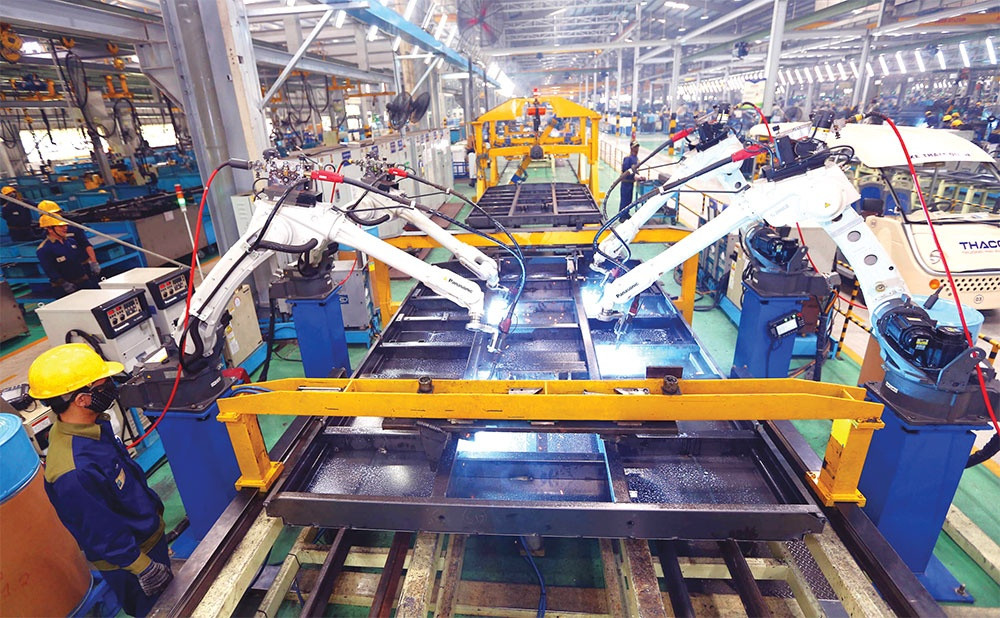 |
| Not enough components of a vehicle are made in the country itself, industry leaders say, photo Le Toan |
Over three days in June, Ho Chi Minh City will host Automechanika 2023, an auto parts and service industry exhibition. According to Dr. Phan Dang Tuat, chairman of the Vietnam Association for Supporting Industries, the event will lay bare the fact that Vietnam still has a lot to do in terms of building a robust automobile industry, with more components being made in the country itself.
“In order to have an automobile industry, the first thing needed is a basic science and technology background. Then, there must be a material industry to produce alloy steel,” Tuat said. “But, currently, on a car with more than 20,000 components and 200 steel components, Vietnam cannot make any of those steel components. It is not self-sufficient and has to import entirely from abroad.”
However Pham Van Tai, general director of Truong Hai Auto Corporation (THACO), said while many of the company’s passenger cars have had a localisation rate of 30-40 per cent in the past, this figure is gradually increasing as sales increase. The company is now able to demonstrate its mettle on a wider stage.
“As an example, we have exported components to Kia’s factories in the region, such as the front bumper of Kia Sorento cars,” said Tai.
In fact, some models through Thaco Truong Hai now boast a localisation rate of up to 70 per cent.
Its capacity is also demonstrated by supplying original equipment manufacturer parts for many automobile and motorbike manufacturers in Vietnam such as Hyundai, Toyota, and Piaggio as well as enterprises such as General Electric and Doosan Vina. It also exports to key markets in North America, Australia, the United Kingdom, Scandinavia, and more.
Today, there are more than 40 enterprises engaged in the production and assembly of automobiles in Vietnam. By the end of 2022, more than 400 enterprises supplying components met Vietnam’s level 1 supplier standards for major auto manufacturers, an increase of more than 200 per cent compared to 2016.
Most of Toyota Vietnam’s cars have achieved a localisation rate of 40 per cent. There are 58 Toyota suppliers, of which 12 are pure Vietnamese suppliers, while the total number of localised products has reached 1,000.
In terms of electric vehicles, VinFast is currently a pioneer with a 60 per cent localisation rate involving the chassis, interior and exterior parts, the electrical system, and automation.
Nguyen Ngo Long, chairman of Nhat Long Mechanical Trading, noted that localisation is still not strong enough, however. His business has been able to enter the supply chain when supplying mechanical components to a number of foreign groups in Japan and South Korea.
However, the low localisation rate means prices of domestically manufactured and assembled cars are higher than imported ones. “Vietnam’s rate is the lowest compared to ASEAN countries such as Thailand, Indonesia, and Malaysia,” Long said.
Vu Tan Cong, who has nearly 40 years of experience in managing and trading cars at foreign-invested companies, pointed out that the main criteria for the auto supporting industry to develop is that average passenger car sales of any one model must be at least about 2,500 per month. In Vietnam, the only model to have met the criteria is the Toyota Vios.
“Currently, based on growth rates and vehicle owner numbers, the Vietnamese auto market does have a lot of potential and can be fully expanded. The problem is that product quality and the price must match,” said Cong.
He added that within the current globalisation context, it is not necessary for Vietnam to make all products from beginning to end. But key industrial products – not only in the auto market but also in electronics, textiles, and more – should be a focus so Vietnam gains more funding in materials and supporting industries.
“With that, the added value of the products will be enhanced and there will be more autonomy in the supply of raw materials, thereby helping to attract many foreign corporations to set up factories,” Cong insisted.
He added that it was necessary for new policies to promote the association of multinational companies and foreign investors to find new Vietnamese suppliers, and at the same time to encourage more localisation by offering encouraging policies on tax, labour, and research and development.
Nghiem Xuan Da, chairman of the Vietnam Steel Association, also believes that Vietnam can completely make manufactured steel products, but the market size is currently too small to stimulate businesses to invest in making these products.
“Thailand and Indonesia produce millions of cars a year, so they can produce fabricated steel. In Vietnam, they only produce a few hundred thousand cars a year. It’s not enough for enterprises to invest in production,” Da said.
Source: VIR